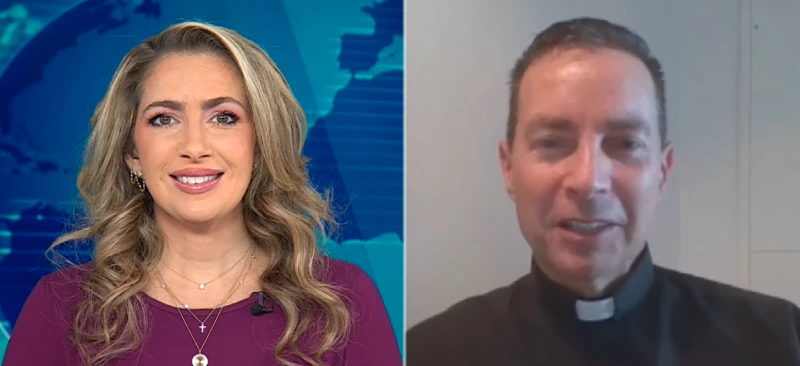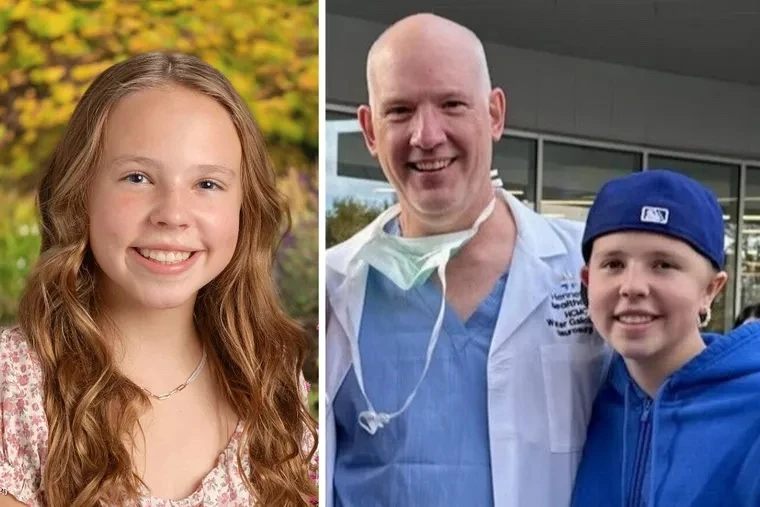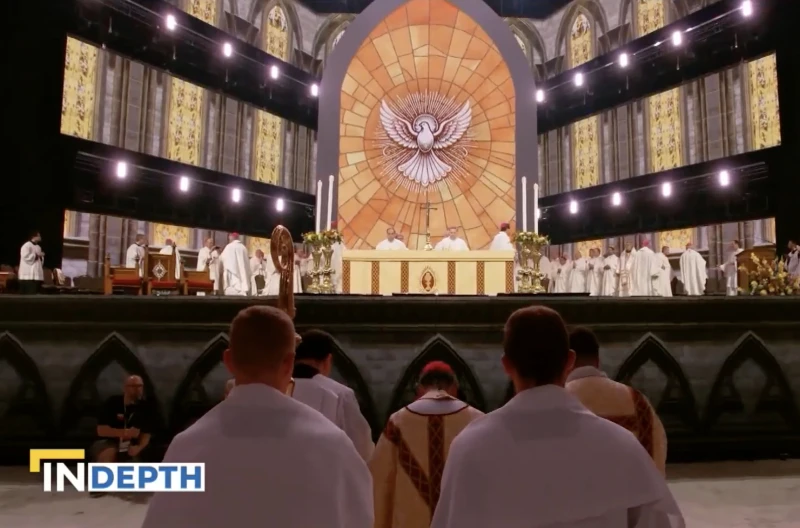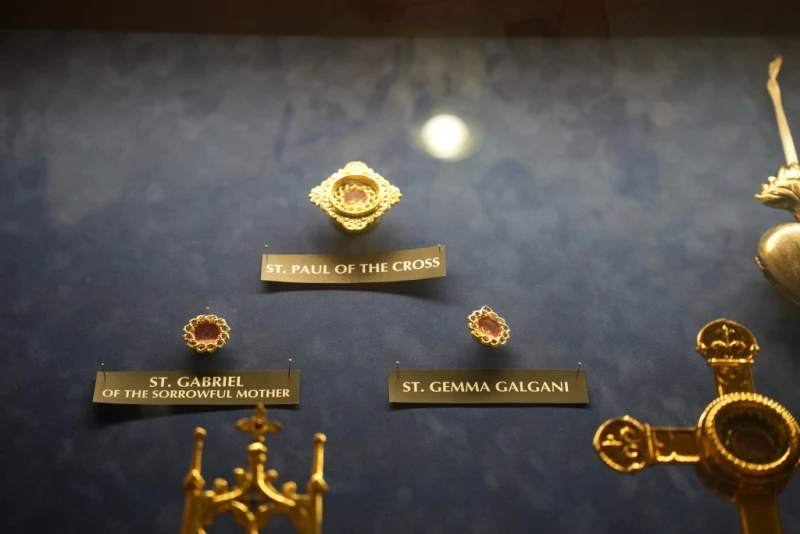

Father Burke Masters speaks to Veronica Dudo on "EWTN News Nightly" on Friday, Oct. 24, 2025 / Credit: EWTN News
Washington, D.C. Newsroom, Oct 25, 2025 / 07:00 am (CNA).
Father Burke Masters’ first dream was to be a major league baseball player, but after feeling a call from God to the priesthood he now uses the sport “to speak about Jesus and the Church.”
“I played college baseball at Mississippi State University, and then played briefly in the minor leagues,” Masters said. “That was my dream to be a major league baseball player, but that didn’t work out.”
“God eventually called me to be a priest,” Masters said in an Oct. 24 interview with “EWTN News Nightly.” He added: “It really wasn’t what I wanted, but it was this persistent and gentle call from the Lord.”
“I went to seminary fully thinking I would go … not like it, and then go back to my plans,” Masters said. “Yet when I got to seminary I just felt this overwhelming peace, and that’s one of the fruits of the Holy Spirit.”
Masters was ordained in 2002, serving as priest in Illinois. Eventually though, baseball did become a part of his career when he was named the chaplain of the Chicago Cubs in 2013.
“God brought baseball back into my life in a way that I never expected,” Masters said. “Since then, people have called me the ‘baseball priest,’ because I love to connect faith with sports.”
While Masters’ “full-time job” was as a pastor in the Diocese of Joliet, he attended all the Cubs’ home games. As the “baseball priest,” Masters was chaplain when they won the World Series in 2016.
“One of my big messages to the players then and to the players now would be: ‘Just remember your identity, you’re beloved sons of God. Your identity is not in the sport of baseball.’ And what I find that helps players … relax to say: ‘Yes, this is a big game. Millions of people are watching, but in the end, it’s still just a game. And life goes on,’” he said.
Connecting faith and sports
In 2023, Masters published a book, “A Grand Slam for God: A Journey from Baseball Star to Catholic Priest.” He wrote about his childhood outside of Chicago, his success in baseball, his conversion to Catholicism, and his acceptance of his vocation.
His story discusses his doubts and personal loss, and how he learned to embrace his identity not as an athlete but as a son of God and spiritual leader.
“Baseball taught me a lot of things, among them, discipline, hard work, and how to work with people of a lot of different backgrounds,” Masters said. “I find that to be so helpful in my life as a priest, as a vocation director, as a pastor, that I try to invest a lot of time in my spiritual life.”
“Also, baseball has given me a way to … reach people who are not close to God at the moment by bringing stories about baseball and my sports background,” Masters said. “It gives me an opening to speak about Jesus and the Church. It’s just been a great gift.”
In homilies, Masters said he will “bring up the sport of baseball.” He added: “I can see some of the people who love the sport perk up and then can bring the Gospel message to them more easily.”
Ahead of the 2025 World Series on Oct. 24, Masters shared with EWTN his predictions for the outcome. He said: “If I go off my head, the Dodgers will win, but I love pulling for the underdog. So my heart is going with the Toronto Blue Jays.”
Read More








![Faith-based ministries discuss how to further pro-life mission #Catholic
Kat Talalas, Amy Ford, Christopher Bell, and Sister Maria Frassati, SV, speak at the Leading with Love Conference at The Catholic University of America in Washington, D.C., on Oct. 8, 2025. / Credit: Tessa Gervasini/CNA
Washington, D.C., Oct 9, 2025 / 12:55 pm (CNA).
Pro-life leaders from across the country gathered this week to discuss how faith-based ministries are helping to cultivate a society that promotes human dignity and how others can advance the cause.The Leading with Love Conference at The Catholic University of America (CUA) in Washington, D.C., was sponsored by the Human Life Foundation and the Center for Law and the Human Person at The Catholic University of America’s Columbus School of Law. It was aimed at “empowering Christians to cultivate a culture of life within their local communities.”Jennie Bradley Lichter, president of the March for Life Education and Defense Fund, spoke to attendees Oct. 8 about the power of faith-based ministries, including The Guadalupe Project. Lichter founded the initiative in 2022 to provide resources and encouragement to parents within the CUA community.To cultivate this encouragement, we must figure out how we can “create more of a revolution of love,” Lichter said. “Christ started this revolution of love, but it’s now up to each one of us in our particular time and place.”“Caring for unborn babies and their mothers is one of the most urgent challenges of our time, Lichter said. “Six out of 10 women who have chosen abortion would have preferred to choose life if they had the emotional and financial support they felt necessary.” The Guadalupe Project’s goal was to combat this by “[making] sure every woman on campus knows that resources exist and knows exactly how to find them,” Lichter said. “It’s meant to support all parents on campus, not just students, and not just mothers in unexpected or challenging circumstances.”“We wanted to foster a culture on campus where each life is celebrated, knowing that a positive, vibrant, and joyful culture of life is truly life-giving in so many ways,” Lichter said. The initiative “revamped all of the university’s pregnancy resource materials for students” and created “a poster campaign, including one designed specifically for the men’s dorms,” Lichter said.It also promoted the placement of stickers in every women’s restroom stall on campus with a QR code leading to these pregnancy materials. The campus started allotting more maternity and paternity leave, designating maternity parking spots on campus, providing free diapers and wipes at the campus food pantry, holding maternity clothing drives, and “affirming the goodness of family life and that new babies are a moment to celebrate,” Lichter said.The 2026 theme for the March for Life is “Life Is a Gift,” Lichter said. The initiative helps carry that out, because “life is something to be celebrated.” She added: “[Life] is not a burden for which someone needs support, or not solely that. It is really a cause for celebration.” Faith-based communities can use The Guadalupe Project as “prototype,” Lichter suggested. She shared that other universities have reached out to talk about the initiative as they were inspired to consider doing something similar.“We need to make sure that pregnant women never reach the point of despair that drives them into the arms of the abortion clinics,” Lichter said. “We need to meet that moment of loneliness, fear, or emptiness with encouragement and empowerment.”Hopes and suggestions for faith-based ministries Other leaders from prominent pro-life ministries discussed what gives them hope for the future of the pro-life movement, including Kat Talalas of Walking with Moms in Need, Amy Ford of Embrace Grace, Christopher Bell of Good Counsel Homes, and Sister Maria Frassati of the Sisters of Life.Talalas, who is the assistant director of pro-life communications for the U.S. Conference of Catholic Bishops, said Walking with Moms in Need started five years ago but has already reached countless communities. The parish-based initiative is “to the point where we don’t even know a lot of the time what new diocese or parish is starting a Walking with Moms in Need, what new lives are being saved, [and] what new women are being accompanied,” Talalas said. “It’s taken on a life of its own. That’s the work of the Holy Spirit — the Holy Spirit convicting hearts.”“God guides us, we have each other, and we’re not alone. Just as we tell [mothers] that they’re not alone, we’re not alone in this movement. So what’s giving me hope is seeing the Holy Spirit catch fire and individual people saying: ‘I want to start talking with moms in need,’ and women saying: ‘I can do this,’” Talalas said. Talalas said the work all begins with prayer. “It’s sitting in the presence of the love of God, letting him love you, and seeing how the Holy Spirit convicts you … It begins with that individual conviction. If we’re not following God’s law, it doesn’t matter what we’re doing.”Ford, who leads Embrace Grace, which provides mothers support through local churches, said she has “noticed there’s a lot of people that seem like they have more of an open heart about Christianity, about spirituality … especially with the younger generation.” She added: “I think that’s something we can all have hope about.”To get involved, Ford said people need to carry out “the good works that God’s called us to do.” She posed the question: “What strengths and gifts did God put inside each of you that you can do?” While Bell’s ministry, Good Counsel, provides services including housing for homeless mothers and children and post-abortion healing services, he said every person can help by simply praying. He specifically called on people to pray in front of an abortion center. “If you have done it, do it again. If you’ve never done it, just go ... You don’t have to say anything. You didn’t have to look up. You don’t have to open your eyes. But your presence will mean the world,” Bell said. “The babies who will die there that day will know that you loved them … That’s the most important thing to do.”Sister Maria Frassati shared that “we could really grow in having more faith in what [God] is doing.”“The truth is that God is actually really working in so many ways,” she said. “God is faithful, and that really gives me a lot of hope that nothing that you give is ever wasted. Even if you walk with a woman who’s not receptive, there’s really no gift that has been offered to him that he has not kept sacred and precious in his heart.”](https://unitedyam.com/wp-content/uploads/2025/10/faith-based-ministries-discuss-how-to-further-pro-life-mission-catholic-kat-talalas-amy-ford-christopher-bell-and-sister-maria-frassati-sv-speak-at-the-leading-with-love-conference-at-the-ca.webp)









